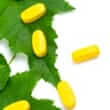Background
- Butcher's broom is a small evergreen shrub that grows throughout Europe and North Africa. Historically, European butchers may have used the leaves and twigs of the Ruscus aculeatus plant to clean and scrub their chopping blocks, hence the name "butcher's broom." The rhizome shoots of butcher's broom may be eaten as food in many cultures. Both the root and the stem are used as part of herbal preparations.
- Butcher's broom may have been used for the past 2,000 years for its beneficial effects on the circulatory system. These beneficial effects may include promoting vein narrowing and improving the tone of blood vessel walls. The chemicals found in butcher's broom may attach to and strengthen certain parts of blood vessels, especially collagen, resulting in a tightening of blood vessels, which allows blood to circulate throughout the body and provides greater flexibility to blood vessel walls.
- Today, butcher's broom is most frequently used in combination with hesperidin methyl chalcone (150mg) and vitamin C (100mg) in a product known as Cyclo 3 Fort®, which is used to treat certain circulatory diseases, particularly chronic venous insufficiency (CVI).
- Butcher's broom has also been studied as a treatment for other diseases and conditions, including varicose veins, secondary lymphedema (swelling due to excess fluid) of the upper arm after breast cancer treatment, and premenstrual syndrome symptoms, and for healing sprains and contusions. However, most of these studies have evaluated butcher's broom herbal combinations, so the effect of butcher's broom alone is still unclear. Further research is required.
- Butcher's broom may have been used by the ancient Greeks as a diuretic (an agent that promotes urine) and laxative. Historically, throughout Europe, it may have been used to regulate menstrual periods, to get rid of jaundice and headaches, and to heal broken bones. Butcher's broom has also been used to increase sweating, to treat gout and kidney stones, and to promote improved blood flow.
References
- Archimowicz-Cyrylowska B. Clinical effect of buckwheat herb, Ruscus extract and troxerutin on retinopathy and lipids in diabetic patients. Phytotherapy Res 1996;10:659-662.
- Beltramino R, Penenory A, Buceta AM. An open-label, randomised multicentre study comparing the efficacy and safety of CYCLO 3 FORT versus hydroxyethyl rutoside in chronic venous lymphatic insufficiency. Int Angiol. 1999;18(4):337-342. View Abstract
- Bennani A, Biadillah MC, Cherkaoui A. Acute attack of hemorrhoids: Efficacy of. Cyclo 3 Fort® based on results in 124 cases reported by specialists. Phlebologie 1999;52:89-93.
- Boyle P, Diehm C, Robertson C. Meta-analysis of clinical trials of Cyclo 3 Fort in the treatment of chronic venous insufficiency. Int Angiol. 2003;22(3):250-262. View Abstract
- Cappelli R, Nicora M, Di Perri T. Use of extract of Ruscus aculeatus in venous disease in the lower limbs. Drugs Exp Clin Res 1988;14(4):277-283. View Abstract
- Cluzan RV, Alliot F, Ghabboun S, Pascot M. Treatment of secondary lymphedema of the upper limb with CYCLO 3 FORT. Lymphology 1996;29(1):29-35. View Abstract
- Lagrue G, Behar A, Chaabane A., and Laurent, J. Edema induced by calcium antagonists. Effects of Ruscus extract on clinical and biological parameters. In: Vanhoutte, P. M. Return Circulation and Norepinephrine: An Update. Paris: John Libbey Euretext;1991.
- Landa N, Aguirre A, Goday J, Raton JA, Diaz-Perez JL. Allergic contact dermatitis from a vasoconstrictor cream. Contact Dermatitis 1990;22(5):290-291. View Abstract
- MacKay D. Hemorrhoids and varicose veins: a review of treatment options. Altern Med Rev 2001;6(2):126-140. View Abstract
- Monteil-Seurin J. Efficacy of Ruscus extract in the treatment of the premenstrual syndrome. In: Vanhoutte, P. M. Return Circulation and Norepinephrine: An Update. Paris: John Libbey Euretext;1991.
- Parrado F, Buzzi A. A Study of the Efficacy and Tolerability of a Preparation Containing Ruscus aculeatus in the Treatment of Chronic Venous Insufficiency of the Lower Limbs. Clinical Drug Investigation, 1999;8(4):255.
- Redman DA. Ruscus aculeatus (butcher's broom) as a potential treatment for orthostatic hypotension, with a case report. J Altern Complement Med 2000;6(6):539-549. View Abstract
- Rudofsky G. [Improving venous tone and capillary sealing. Effect of a combination of Ruscus extract and hesperidine methyl chalcone in healthy probands in heat stress]. Fortschr.Med 6-30-1989;107(19):52, 55-52, 58. View Abstract
- Vanscheidt W, Jost V, Wolna P, et al. Efficacy and safety of a Butcher's broom preparation (Ruscus aculeatus L. extract) compared to placebo in patients suffering from chronic venous insufficiency. Arzneimittelforschung 2002;52(4):243-250. View Abstract
- Weindorf N, Schultz-Ehrenburg U. [Controlled study of increasing venous tone in primary varicose veins by oral administration of Ruscus aculeatus and trimethylhespiridinchalcone]. Z.Hautkr. 1-1-1987;62(1):28-38. View Abstract







